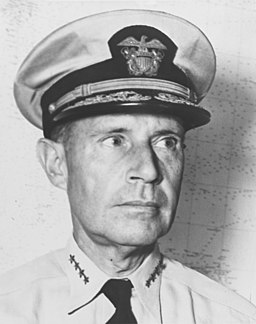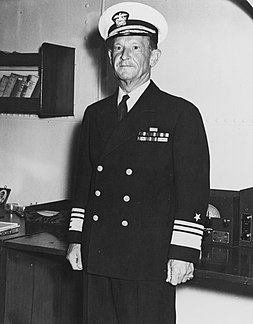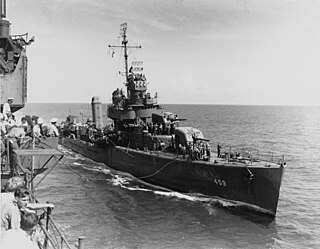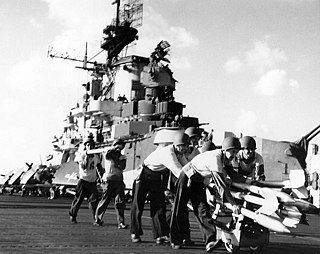
A cruiser is a type of warship. Modern cruisers are generally the largest ships in a fleet after aircraft carriers and amphibious assault ships, and can usually perform several roles.

The Battle of Leyte Gulf was the largest naval battle of World War II and, by some criteria, the largest naval battle in history, with over 200,000 naval personnel involved. It was fought in waters near the Philippine islands of Leyte, Samar, and Luzon, from 23 to 26 October 1944, between combined American and Australian forces and the Imperial Japanese Navy (IJN), as part of the invasion of Leyte, which aimed to isolate Japan from the countries it had occupied in Southeast Asia which were a vital source of industrial and oil supplies.

Raymond Ames Spruance was a United States Navy admiral during World War II. He commanded U.S. naval forces during one of the most significant naval battles that took place in the Pacific Theatre: the Battle of the Philippine Sea. He also commanded Task Force 16 at the Battle of Midway, comprising the carriers Enterprise and Hornet. At Midway, dive bombers from the Enterprise crippled two carriers of the Imperial Japanese Navy, Kaga and the flagship Akagi. Most historians consider Midway the turning point of the Pacific War.

The Battle of the Philippine Sea was a major naval battle of World War II that eliminated the Imperial Japanese Navy's ability to conduct large-scale carrier actions. It took place during the United States' amphibious invasion of the Mariana Islands during the Pacific War. The battle was the last of five major "carrier-versus-carrier" engagements between American and Japanese naval forces, and pitted elements of the United States Navy's Fifth Fleet against ships and aircraft of the Imperial Japanese Navy's Mobile Fleet and nearby island garrisons. This was the largest carrier-to-carrier battle in history, involving 24 aircraft carriers, deploying roughly 1,350 carrier-based aircraft.

The Battle of Rennell Island took place on 29–30 January 1943. It was the last major naval engagement between the United States Navy and the Imperial Japanese Navy during the Guadalcanal Campaign of World War II. It occurred in the South Pacific between Rennell Island and Guadalcanal in the southern Solomon Islands.

The Naval Battle of Guadalcanal, sometimes referred to as the Third and Fourth Battles of Savo Island, the Battle of the Solomons, the Battle of Friday the 13th, or, in Japanese sources, the Third Battle of the Solomon Sea, took place from 12–15 November 1942, and was the decisive engagement in a series of naval battles between Allied and Imperial Japanese forces during the months-long Guadalcanal Campaign in the Solomon Islands during World War II. The action consisted of combined air and sea engagements over four days, most near Guadalcanal and all related to a Japanese effort to reinforce land forces on the island. The only two U.S. Navy admirals to be killed in a surface engagement in the war were lost in this battle.

The Battle of the Santa Cruz Islands, fought during 25–27 October 1942, sometimes referred to as the Battle of Santa Cruz or Third Battle of Solomon Sea, in Japan as the Battle of the South Pacific, was the fourth aircraft carrier battle of the Pacific campaign of World War II. It was also the fourth major naval engagement fought between the United States Navy and the Imperial Japanese Navy during the lengthy and strategically important Guadalcanal campaign. As in the battles of the Coral Sea, Midway, and the Eastern Solomons, the ships of the two adversaries were rarely in sight or gun range of each other. Instead, almost all attacks by both sides were mounted by carrier- or land-based aircraft.

The Battle off Samar was the centermost action of the Battle of Leyte Gulf, one of the largest naval battles in history, which took place in the Philippine Sea off Samar Island, in the Philippines on October 25, 1944. It was the only major action in the larger battle in which the Americans were largely unprepared. The Battle off Samar has been cited by historians as one of the greatest last stands in naval history; ultimately the Americans prevailed over a massive armada—the Imperial Japanese Navy's Center Force under command of Vice Admiral Takeo Kurita—despite their very heavy casualties and overwhelming odds.

Frank Jack Fletcher was an admiral in the United States Navy during World War II. Fletcher commanded five different task forces through WWII; he was the operational task force commander at the pivotal battles of the Coral Sea and Midway, which collectively resulted in the sinking of six Japanese fleet carriers.

Takeo Kurita was a vice admiral in the Imperial Japanese Navy during World War II.

The "largest naval battle in history" is a disputed title between adherents of varying criteria which include the numbers of personnel and/or vessels involved in the naval battle, and the total displacement of the vessels involved. While battles fought in modern times are comparatively well-documented, the figures from those in pre-Renaissance era are generally believed by contemporary chroniclers to be exaggerated.

Thomas Cassin Kinkaid was an admiral in the United States Navy, known for his service during World War II. He built a reputation as a "fighting admiral" in the aircraft carrier battles of 1942 and commanded the Allied forces in the Aleutian Islands Campaign. He was Commander Allied Naval Forces and the Seventh Fleet under General of the Army Douglas MacArthur in the Southwest Pacific Area, where he conducted numerous amphibious operations, and commanded an Allied fleet during the Battle of Leyte Gulf, the largest naval battle of World War II and the last naval battle between battleships in history.

The Battle of the Mediterranean was the name given to the naval campaign fought in the Mediterranean Sea during World War II, from 10 June 1940 to 2 May 1945.

Crossing the T or capping the T is a classic naval warfare tactic used from the late 19th to mid 20th centuries, in which a line of warships crosses in front of a line of enemy ships, allowing the crossing line to bring all their guns to bear while receiving fire from only the forward guns of the enemy.
The Imperial Japanese Navy in World War II, at the beginning of the Pacific War in December 1941, was the third most powerful navy in the world, and the naval air service was one of the most potent air forces in the world. During the first six months of the war, the Imperial Japanese Navy enjoyed spectacular success inflicting heavy defeats on Allied forces, being undefeated in every battle. The attack on Pearl Harbor crippled the battleships of the US Pacific Fleet, while Allied navies were devastated during Japan's conquest of Southeast Asia. Japanese Navy aircraft operating from land bases were also responsible for the sinkings of HMS Prince of Wales and HMS Repulse which was the first time that capital ships were sunk by aerial attack while underway. In April 1942, the Indian Ocean raid drove the Royal Navy from South East Asia. After these successes, the Japanese now concentrated on the elimination and neutralization of strategic points from where the Allies could launch counteroffensives against Japan's conquests. However, at Coral Sea the Japanese were forced to abandon their attempts to isolate Australia while the defeat at Midway saw them forced on the defensive. The campaign in the Solomon Islands, in which the Japanese lost the war of attrition, was the most decisive; they had failed to commit enough forces in sufficient time.

USS Laffey (DD-459) was a Benson-class destroyer of the United States Navy during World War II. She was the first destroyer named for Bartlett Laffey.

The Formosa Air Battle, 12–16 October 1944, was a series of large-scale aerial engagements between carrier air groups of the United States Navy Fast Carrier Task Force, and Japanese land-based air forces of the Imperial Japanese Navy (IJN) and Imperial Japanese Army (IJA).

P.T.O. IV, released as Teitoku no Ketsudan IV (提督の決断IV) in Japan, is a World War II-themed strategy for the PlayStation 2 and PC produced by Koei. It focuses on naval combat in the maritime theaters of World War II, encompassing the Pacific Ocean, Mediterranean Sea, Atlantic Ocean, and Indian Ocean, with the option of playing as one of four major maritime powers of the time: Germany, Japan, the United Kingdom, or the United States. P.T.O. IV is the latest game in Koei's P.T.O. series.

World War II saw the end of the battleship as the dominant force in the world's navies. At the outbreak of the war, large fleets of battleships—many inherited from the dreadnought era decades before—were one of the decisive forces in naval thinking. By the end of the war, battleship construction was all but halted, and almost every remaining battleship was retired or scrapped within a few years of its end.
At the beginning of World War II, the Royal Navy was the strongest navy in the world, with the largest number of warships built and with naval bases across the globe. It had over 15 battleships and battlecruisers, 7 aircraft carriers, 66 cruisers, 164 destroyers and 66 submarines. With a massive merchant navy, about a third of the world total, it also dominated shipping. The Royal Navy fought in every theatre from the Atlantic, Mediterranean, freezing Northern routes to Russia and the Pacific ocean.


















